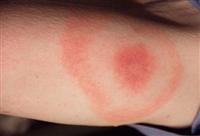Top Lyme Disease Myths
By Guest Blogger Katherine R. Schafer MD, Assistant Professor of Infectious Diseases, Wake Forest Baptist Health
Most people are aware that ticks can carry diseases, but beyond that, they’re often uncertain about what those diseases are and how to spot them. Lyme disease, in particular, carries with it a lot of confusion and misunderstanding.
Myth #1: Lyme disease hasn’t spread to North Carolina.
Reality: While Lyme disease is more common in the Northeast and upper Midwest, it can occur in Southeastern states. In 2013, there were 173 cases of Lyme disease in North Carolina, including cases from Guilford County.
Myth #2: It’s not necessary to check your child for ticks every day.
Reality: When it comes to preventing Lyme disease, time is of the essence. It takes a tick 36-48 hours to transmit the Lyme bacteria (Borrelia burgdorferi) into its host. So spotting and removing ticks as soon as possible reduces risk. In addition, ticks can be picked up anywhere during the summer months. While areas with lots of trees and high grass are especially rife with ticks, many urban and suburban areas can play host to them as well.
Myth #3: The best way to remove ticks is to burn them or cover them with nail polish remover.
Reality: These methods are dangerous and do little to actually remove the tick from the skin. The best way to remove a tick is to gently pull it out with a pair of tweezers. Be sure to get the tweezers as close to the skin as possible and then pull the tick out in a straight motion. Twisting your hand or only grabbing the top of the tick may result in incomplete removal. After the tick has been removed, thoroughly clean the area of skin where it was located.
Myth #4: If your child doesn’t develop a rash, it means he or she hasn’t been infected with Lyme disease.
Reality: While a bull’s-eye rash is considered a hallmark of Lyme disease, it’s not present in everyone who develops the illness. So as you check your child for ticks, be on the lookout for red or bumpy areas—particularly in a ring pattern—as well. Other symptoms of Lyme disease include fever, chills, aches and headaches which are common symptoms for other tick-borne illnesses as well.
Myth #5: Lyme disease always resolves on its own.
Reality: In some cases, Lyme disease may completely resolve on its own. However, most people who develop the illness require a 14 day course of antibiotics to treat the Lyme bacteria. If Lyme disease goes untreated, it can rarely lead to additional complications, such as joint pain and neurological symptoms.
Myth #6: Lyme disease can become chronic and require long-term antibiotic treatment.
Reality: The term “chronic Lyme disease” is often used in these situations. While sometimes Lyme disease symptoms can last after finishing the antibiotics (“Post-Treatment Lyme Disease Syndrome”), the symptoms generally resolve over time and it does not mean that the infection persists. Research shows that there is no persistence of the bacteria and no benefit to prolonged antibiotic treatment. In addition, there are significant risks with long-term antibiotic use.
Myth #7: Lyme disease is the main tick-borne illness your family should be concerned about.
Reality: Lyme is generally not a severe illness and, in North Carolina, Lyme is much less common than other tick-borne illnesses. Ticks can spread a number of diseases, including Rocky Mountain Spotted Fever, other spotted fever illnesses, and STARI (Southeastern tick-associated rash illness). Checking yourself and your child for ticks (and removing them if present) daily during warm-weather months is a good habit. It can be helpful to mark your calendar if you do remove a tick so your doctor can know when you may have been exposed if you do develop any symptoms.
If anyone in your family does develop a rash or flu-like symptoms after being bitten by a tick, contact your primary care provider promptly. To schedule an appointment with a Wake Forest Baptist Health primary care physician, call 336-716-WAKE (9253).
Sponsored by Wake Forest Baptist Health
*Photo from the CDC







